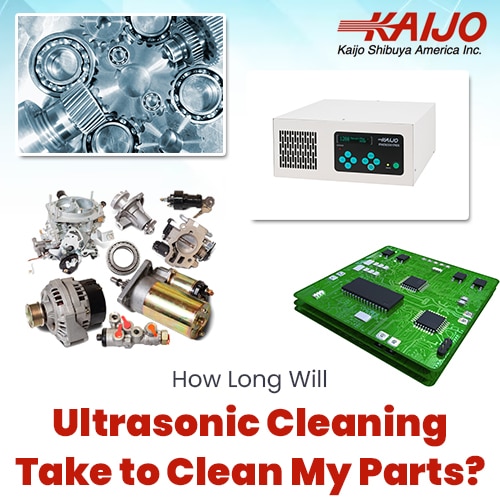How Long Will Ultrasonic Cleaners Take to Clean My Parts?
October 5, 2023
 Editor’s Note: This article was originally published in May 2018 and has been updated with new information and reposted in October 2023.
Editor’s Note: This article was originally published in May 2018 and has been updated with new information and reposted in October 2023.
In today’s advanced industrial environment, achieving peak efficiency is intertwined with maintaining the highest standards of cleanliness.
Ultrasonic cleaning technology has transformed modern industrial practices, offering precise and effective solutions. The time required for an industrial ultrasonic cleaner to clean effectively will depend on the nature of the contaminant and the part’s material. The time needed for cleaning various contaminants will vary across a range:
- Light Dirt or Particles: In just a few minutes for a near-immaculate finish.
- Soft Films or Soluble Materials: Typically, anywhere between 10 to 20 minutes, depending on the solubility.
- Hardened Deposits: The process might extend well beyond 20-30 minutes for contaminants like caked-on grease, especially if the system incorporates heat.
Whether you’re an engineer trying to optimize a manufacturing process or a facility manager striving for operational excellence, understanding the potential of using industrial ultrasonic cleaners for your application can lead to better decision-making, enhanced efficiency, and superior outcomes. This article dives into this technology’s applications and Kaijo’s expertise.
Ultrasonic Cleaning Methods and Their Advantages
Ultrasonic cleaning combines science and innovation, offering unprecedented cleaning efficiency by employing cavitation bubbles formed by high-frequency sound waves. These minute yet powerful cavitation bubbles produce shock waves upon collapsing, ensuring intensive cleaning.
Frequency’s Role: The chosen Frequency plays a crucial role in shaping the cleaning process:
- High Frequencies (400kHz and above): Produce smaller bubbles for gentle cleaning of delicate items like semiconductors.
- Mid Frequencies (70 to 200kHz)
- Low Frequencies (20 to 40kHz): These frequencies produce larger bubbles, allowing for in-depth cleaning of sturdy components, including hard metal parts.
Power’s Effect: The power of the ultrasonic system also affects how quickly it cleans. If the power is too low, there are less cavitation bubbles for cleaning parts, increasing cleaning time. Optimal power ensures maximum bubble generation for quick and thorough cleaning.
Understanding the interplay between frequency and power enables professionals to customize ultrasonic cleaning to specific needs to achieve optimal results.
Examining Different Types of Contaminants
The speed and effectiveness with which industrial ultrasonic cleaners can remove dirt depends on how heavy the contamination is and the nature of the contaminant. The material of the part being cleaned also plays a role because cleaning speeds up if mild solvents or detergents are added to the cleaning solution or the bath is heated. If the part being cleaned is sensitive to the chemicals or could be damaged by heat, these measures can’t be applied, and cleaning will take longer. Understanding the nature of the contaminants as well as the material of the part being cleaned are essential factors for determining the optimal ultrasonic cleaning strategy.
Classifying Contaminants: Contaminants can range from light particulate matter to caked-on residues. Let’s break it down:
- Light Dirt or Particles: These debris are often the easiest to dislodge. Ultrasonic cleaning typically removes these contaminants rapidly, resulting in immaculate parts.
- Soft Films or Soluble Materials: Soft films or soluble materials typically consist of water-soluble contaminants or those that dissolve quickly in certain solvents. With a suitable solvent or mild detergent, ultrasonic cleaning can easily remove these.
- Hardened Deposits: Tackling harsh contaminants such as caked-on grease or carbon can be particularly challenging. They might require a combination of heat and ultrasonic action, but the results are usually better than traditional cleaning methods.
Tailoring Strategies for Effective Cleaning: Effective ultrasonic cleaner use requires more than simply turning it on for optimal results. It involves using a tailored strategy:
- Solvents & Detergents: For contaminants that dissolve quickly in certain chemicals, adding the appropriate solvent or mild detergent may speed up the cleaning process.
- Heat: For hardened contaminants, using heat can soften them up, making ultrasonic cleaners more effective at their task.
Understanding and categorizing various contaminants requires tailored cleaning strategies. Recognizing these nuances allows one to use ultrasonic cleaning at its full potential, guaranteeing flawless parts and enhanced operational efficiency. Whether you’re a process engineer dealing with product quality or a manufacturing engineer aiming for operational excellence, recognizing these nuances is indispensable.
Considerations for Materials of Various Nature
Ultrasonic cleaning’s versatility is one of its significant assets, yet not every material responds to this method similarly. A comprehensive understanding of material properties can assist professionals in selecting appropriate ultrasonic techniques that ensure both safety and effectiveness in ultrasonic cleaning techniques.
Diverse Material Complexities:
- Delicate Materials: Semiconductors or medical devices may be vulnerable to intense ultrasonic waves. High frequencies, which provide gentler cleaning, are recommended for such materials to prevent potential damage.
- Robust Components: Robust materials such as metal car parts or industrial machinery components can withstand more aggressive cleaning. Low-frequency ultrasonic systems producing larger cavitation bubbles are ideal in these instances.
- Sensitive Structures: Components with soft surfaces or easily damaged structures require a balanced approach. While regular, thorough cleaning may be necessary, the frequency, power, and cleaning solutions should be chosen carefully to prevent material degradation.
Influence of Material Properties on Cleaning Techniques:
- Thermal Sensitivity: Certain materials can be negatively affected by heat. For these, it is essential to avoid heated ultrasonic baths to ensure that temperature stays within safe limits.
- Chemical Reactivity: While solvents and detergents can enhance cleaning, certain materials could react adversely when exposed to certain chemicals. Knowledge of a material’s chemical properties is vital to prevent potential damage.
- Structural Integrity: For parts with intricate designs or internal structures, ensuring the ultrasonic waves won’t compromise their integrity is paramount. Tailoring the ultrasonic process to suit the part’s design and structural intricacies ensures both cleanliness and the preservation of its form.
Ultrasonic cleaning involves an intensive material analysis process. As manufacturing engineers and facility managers know, being mindful of these subtleties ensures not only cleanliness but also prolongs and ensures integrity for any parts they handle.
Comparative Analysis with Traditional Cleaning Methods
While ultrasonic cleaning has long been heralded for its advantages, assessing its benefits is crucial against traditional cleaning methods.
This comparison provides a valuable holistic view that helps professionals select the most cost-efficient, sustainable cleaning options.
Ultrasonic Cleaning vs. Traditional Methods:
While ultrasonic cleaners may take longer for some applications than for others, their overall cleaning performance is much faster and more effective than the traditional methods outlined below:
- Soaking: Soaking can effectively eliminate stubborn contaminants, but the process often requires extensive time and utilizes harsh, sometimes corrosive, chemicals. By contrast, ultrasonic cleaning often achieves comparable or better results quickly while employing milder solutions.
- Scrubbing: A labor-intensive process, scrubbing risks damaging parts and doesn’t always guarantee even cleaning, especially in intricate structures. In contrast, ultrasonic cleaning provides uniform, detailed cleaning without manual effort or potential harm.
- Pressure Washing: While pressure washing may work well for robust parts, ultrasonic waves penetrate even the toughest crevices for thorough cleaning, regardless of part complexity.
Economic and Environmental Benefits:
- Cost Benefits: Although initial investments in ultrasonic equipment might be higher, long-term labor savings, reduced cleaning time, and chemical usage savings provide substantial cost benefits over time.
- Chemical Waste Reduction: Traditional methods often produce significant chemical waste, which must be stored and neutralized. Ultrasonic cleaning is more environmentally friendly, typically generating little waste and eliminating the need for harmful chemicals.
Efficiency Enhancements: Ultrasonic cleaning not only promises cleanliness, it ensures efficiency enhancements as well. Its ability to handle various contaminants across multiple materials, combined with speed and precision, makes it a superior choice in most industrial settings.
For industry professionals, the decision between traditional and ultrasonic cleaning isn’t merely about cleanliness but operational efficiency, cost-effectiveness, and sustainability. As industries move towards more eco-friendly and efficient practices, ultrasonic cleaning’s value proposition becomes even more compelling. This positions ultrasonic cleaning as the modern industry’s preferred choice.
Expertise and Solutions Offered by Kaijo
Kaijo offers unparalleled expertise in ultrasonic cleaning for professionals looking to navigate this vast and ever-evolving field and ensure optimal results and efficiency.
A Diverse assortment of Ultrasonic Cleaning Products:
Kaijo offerings stand out in their breadth and depth:
- Frequency Variants: Whether delicate components require high-frequency systems or robust parts necessitate low-frequency cleaning solutions, Kaijo offers customized solutions tailored to industry requirements.
- Power Options: Power significantly influences cleaning effectiveness. Kaijo’s range includes various power configurations, ensuring that the cleaning process yields optimal results for different applications.
Informed Consulting Services:
More than just a product vendor, Kaijo positions itself as a knowledgeable partner:
- Guided Selection: Each industry has different needs, and Kaijo assists in selecting an ultrasonic cleaning system explicitly tailored to its industry – be it semiconductor manufacturing or heavy machinery maintenance cleaning; their insights make the selection process easy.
- Expertise At Your Disposal: Kaijo has extensive expertise in ultrasonic cleaning technology and provides invaluable guidance, helping clients optimize their cleaning processes and increase efficiency.
For professionals searching for a partner renowned for technical expertise and exceptional performance, Kaijo stands out as a preferred option. Kaijo’s industrial ultrasonic cleaning systems ensure maximum efficiency, thoroughness, and reliability. In addition, Kaijo’s comprehensive approach, from premium ultrasonic systems to professional consulting, ensures that customers receive solutions perfectly tailored to meet their challenges. Contact Kaijo for a free consultation to discuss your specific cleaning application.





